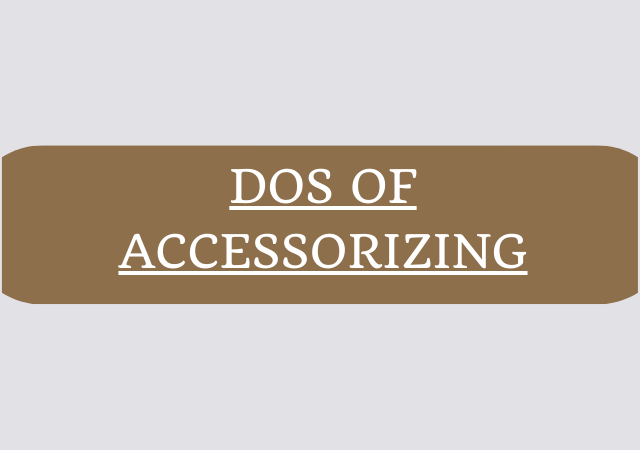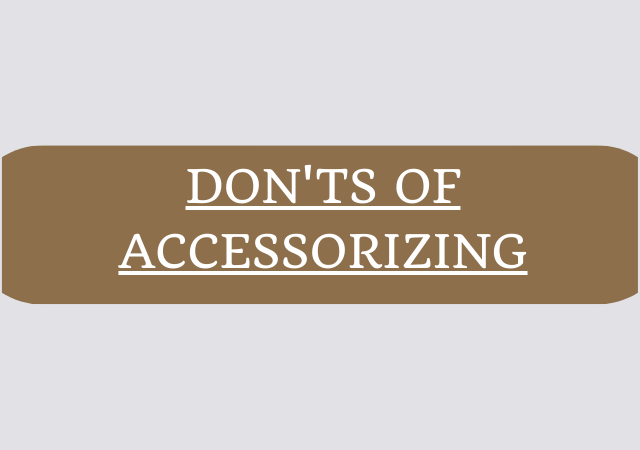The Dos and Don’ts of Accessorizing Your Outfit
Introduction
Accessorizing is a subtle art that can elevate your outfit from mundane to magnificent, adding a personalized touch to your style. The right accessories have the power to complement your clothing, express your personality, and make a lasting impression. However, navigating the world of accessories requires finesse, as missteps can lead to fashion faux pas. In this guide, we will explore “The Dos and Don’ts of Accessorizing Your Outfit,” providing valuable insights into creating a harmonious balance of jewelry, bags, scarves, and more. From color coordination and proportionate layering to expressing individuality and avoiding common pitfalls, this article will serve as your go-to resource for mastering the art of accessorizing. Unlock the secrets to enhancing your fashion ensemble while avoiding the common pitfalls that could undermine your style aspirations.
The Dos and Don’ts of Accessorizing Your Outfit
Dos of Accessorizing

1. Choose accessories that complement your outfit:
-
- Selecting accessories that align with your outfit’s color palette is crucial. Harmonize colors to create a cohesive look that exudes sophistication.
- Ensure the style of your accessories complements your outfit. For casual wear, opt for laid-back accessories, while formal occasions call for more refined choices.
- Consider the occasion – choose accessories that are appropriate for the event, striking a balance between elegance and practicality.
2. Layering with moderation:
-
- When it comes to layering accessories, less is often more. Balance statement pieces with simpler, understated items to avoid overwhelming your look.
- Experiment with mixing metals and textures but do so tastefully. Avoid a clash of styles by maintaining a sense of cohesion.
- Steer clear of over-accessorizing, as it can detract from the overall impact of your outfit. A few well-chosen pieces can speak volumes.
3. Pay attention to proportions:
-
- Different body types and outfits require different accessories. Adjust the scale of your accessories to complement your body shape and the overall silhouette.
- Consider the neckline and silhouette of your clothing when selecting accessories. A delicate necklace may be more suitable for a high neckline, while bold earrings can accentuate a simple dress.
- Strive for a harmonious balance between your outfit and accessories, ensuring one doesn’t overpower the other.
4. Use accessories to highlight your personality:
-
- Personalize your look by incorporating accessories that reflect your individuality. Whether it’s a vintage brooch or a quirky scarf, let your style shine.
- Express your unique taste by experimenting with trends, but do so in a subtle manner. Integrate trendy pieces without sacrificing your personal aesthetic.
- Don’t be afraid to mix and match – the right accessories can transform a basic outfit into a true representation of your style.
Don’ts of Accessorizing

1. Avoid excessive matching:
-
- Resist the temptation to match every accessory to your outfit precisely. Instead, opt for complementary colors and patterns to add visual interest.
- Strike a balance when incorporating prints and patterns. If your outfit is bold, opt for more subdued accessories to avoid overwhelming the look.
- Break away from a matchy-matchy appearance by introducing contrasting elements, creating a more dynamic and visually appealing ensemble.
2. Say no to too many statement pieces:
-
- While statement pieces can elevate your outfit, moderation is key. Focus on one standout accessory at a time to avoid a cluttered and chaotic look.
- Prevent clashes between bold accessories by ensuring they harmonize in terms of style, color, or theme. Allow one statement piece to take center stage, drawing attention without competition.
- Keep the rest of your accessories subtle to maintain a cohesive and polished appearance.
3. Be mindful of the workplace:
-
- In professional settings, adhere to office dress codes and opt for accessories that are polished and conservative.
- Choose subtle accessories that complement your professional attire without distracting from your overall look.
- Respect cultural and organizational norms regarding accessories to ensure you present yourself in a manner that aligns with workplace expectations.
4. Don’t underestimate the power of simplicity:
-
- Embrace the elegance of minimalism. Sometimes, a well-chosen accessory or two can make a more significant impact than an abundance of jewelry.
- Avoid clutter and unnecessary accessories that may distract from the beauty of your outfit. Let each piece play a deliberate role in enhancing your overall look.
- Allow your outfit to breathe by embracing simplicity. Sometimes, less truly is more.
Practical Tips for Accessorizing
1. Consider the occasion and dress code:
-
- Tailor your accessories to the specific event or setting. What works for a casual brunch may not be suitable for a formal evening affair.
- Adhere to dress codes, whether they’re set by an organization or dictated by the nature of the event.
2. Take into account the neckline and neckline accessories:
-
- V-necklines may call for a pendant necklace, while high necklines pair well with stud earrings or a delicate bracelet.
- Pay attention to the details of your outfit and choose accessories that complement rather than compete with them.
3. Think about the color wheel for effective color combinations:
-
- Use the color wheel to guide your accessory choices. Complementary colors or analogous hues can create a visually appealing and harmonious look.
4. Use accessories to enhance or redirect focus:
-
- Draw attention to your favorite features by strategically placing accessories. A waist belt can accentuate your figure, while a statement necklace can highlight your collarbone.
5. Experiment with layering to find what works best for you:
-
- Don’t be afraid to experiment with different combinations of accessories. What suits one outfit may not work for another, so take the time to find your signature style.
Conclusion
In conclusion, mastering the art of accessorizing involves a delicate balance between expression and restraint. The dos of accessorizing emphasize the importance of color coordination, proportionate layering, attention to proportions, and the ability to use accessories as a reflection of personal style. These guidelines encourage an exploration of individuality and creativity while ensuring a harmonious ensemble.
On the flip side, the don’ts caution against excessive matching, overuse of statement pieces, workplace missteps, and underestimating the power of simplicity. Practical tips underscore the significance of considering the occasion, neckline, color combinations, and the strategic use of accessories to enhance or redirect focus. By adhering to these principles, one can confidently navigate the accessory landscape, transforming outfits into personalized statements that leave a lasting impression.

My name is Rohit Vagh and I’m a content writer specializing in fashion and lifestyle. I have three years of experience in this field and have written various articles. My writing style is creative and engaging, and I strive to create content that resonates with my readers. I have a deep passion for fashion and am constantly researching the latest trends and styles to make sure my readers are up to date. I’m excited to continue my career in blogging, and I’m always looking for new opportunities in the fashion and lifestyle space.





